Enhanced Photocatalytic CO2 Reduction via CCH/g-C3N4 Heterojunction: Optimizing Charge Carrier Dynamics and Visible-Light Utilization
Abstract
1. Introduction
2. Results and Discussion
2.1. Morphological and Structural Characterization
2.2. PCR Performance
2.3. Study on Photocatalytic Mechanism
3. Experimental
3.1. Synthesis of Catalysts
3.2. Characterization Studies
3.3. Photoelectrochemical Testing
3.4. Catalytic Activity
4. Conclusions
Supplementary Materials
Author Contributions
Funding
Data Availability Statement
Conflicts of Interest
References
- Maeda, K. Metal-Complex/Semiconductor Hybrid Photocatalysts and Photoelectrodes for CO2 Reduction Driven by Visible Light. Adv. Mater. 2019, 31, 1808205. [Google Scholar] [CrossRef] [PubMed]
- Li, Y.; Hao, J.; Song, H.; Zhang, F.; Bai, X.; Meng, X.; Zhang, H.; Wang, S.; Hu, Y.; Ye, J. Selective light absorber-assisted single nickel atom catalysts for ambient sunlight-driven CO2 methanation. Nat. Commun. 2019, 10, 2359. [Google Scholar] [CrossRef]
- Liu, Y.; Zhang, J.; Li, Y.; Qian, Q.; Li, Z.; Zhu, Y.; Zhang, G. Manipulating dehydrogenation kinetics through dual-doping Co3N electrode enables highly efficient hydrazine oxidation assisting self-powered H2 production. Nat. Commun. 2020, 11, 1853. [Google Scholar] [CrossRef]
- Wagner, A.; Sahm, C.D.; Reisner, E. Towards molecular understanding of local chemical environment effects in electro- and photocatalytic CO2 reduction. Nat. Catal. 2020, 3, 775–786. [Google Scholar] [CrossRef]
- Qiu, B.; Du, M.; Ma, Y.; Zhu, Q.; Xing, M.; Zhang, J. Integration of redox cocatalysts for artificial photosynthesis. Energy Environ. Sci. 2021, 14, 5260–5288. [Google Scholar] [CrossRef]
- Cheng, S.; Sun, Z.; Lim, K.H.; Gani, T.Z.H.; Zhang, T.; Wang, Y.; Yin, H.; Liu, K.; Guo, H.; Du, T.; et al. Emerging Strategies for CO2 Photoreduction to CH4: From Experimental to Data-Driven Design. Adv. Energy Mater. 2022, 12, 2200389. [Google Scholar] [CrossRef]
- Li, H.; Zhao, J.; Luo, L.; Du, J.; Zeng, J. Symmetry-Breaking Sites for Activating Linear Carbon Dioxide Molecules. Acc. Chem. Res. 2021, 54, 1454–1464. [Google Scholar] [CrossRef]
- Chang, X.; Wang, T.; Gong, J. CO2 photo-reduction: Insights into CO2 activation and reaction on surfaces of photocatalysts. Energy Environ. Sci. 2016, 9, 2177–2196. [Google Scholar] [CrossRef]
- Gao, S.; Sun, Z.; Liu, W.; Jiao, X.; Zu, X.; Hu, Q.; Sun, Y.; Yao, T.; Zhang, W.; Wei, S.; et al. Atomic layer confined vacancies for atomic-level insights into carbon dioxide electroreduction. Nat. Commun. 2017, 8, 14503. [Google Scholar] [CrossRef]
- Liu, H.; Chen, Y.; Li, H.; Wan, G.; Feng, Y.; Wang, W.; Xiao, C.; Zhang, G.; Xie, Y. Construction of Asymmetrical Dual Jahn–Teller Sites for Photocatalytic CO2 Reduction. Angew. Chem. Int. Ed. 2023, 62, e202304562. [Google Scholar] [CrossRef] [PubMed]
- Liu, H.; Zhang, F.; Wang, H.; Xue, J.; Guo, Y.; Qian, Q.; Zhang, G. Oxygen Vacancy Engineered Unsaturated Coordination in Cobalt Carbonate Hydroxide Nanowires Enables Highly Selective Photocatalytic CO2 Reduction. Energy Environ. Sci. 2021, 14, 5339–5346. [Google Scholar] [CrossRef]
- Jiao, X.; Zheng, K.; Hu, Z.; Sun, Y.; Xie, Y. Broad-Spectral-Response Photocatalysts for CO2 Reduction. ACS Cent. Sci. 2020, 6, 653–660. [Google Scholar] [CrossRef]
- Li, Y.; Xia, Z.; Yang, Q.; Wang, L.; Xing, Y. Review on g-C3N4-based S-scheme heterojunction photocatalysts. J. Mater. Sci. Technol. 2022, 125, 128–144. [Google Scholar] [CrossRef]
- Wang, X.C.; Maeda, K.; Thomas, A.; Takanabe, K.; Xin, G.; Carlsson, J.M.; Domen, K.; Antonietti, M. A metal-free polymeric photocatalyst for hydrogen production from water under visible light. Nat. Mater. 2009, 8, 76–80. [Google Scholar] [CrossRef]
- Malik, R.; Tomer, V.K. State-of-the-art review of morphological advancements in graphitic carbon nitride (g-CN) for sustainable hydrogen production. Renew. Sust. Energy Rev. 2021, 135, 110235. [Google Scholar] [CrossRef]
- Zhang, J.S.; Chen, Y.; Wang, X.C. Two-dimensional covalent carbon nitride nanosheets: Synthesis, functionalization, and applications. Energy Environ. Sci. 2015, 8, 3092–3108. [Google Scholar] [CrossRef]
- Zhang, F.; Zhang, J.H.; Li, J.M.; Jin, X.; Li, Y.P.; Wu, M.; Kang, X.W.; Hu, T.; Wang, X.Q.; Ren, W.; et al. Modulating charge transfer dynamics for g-C3N4 through a dimension and interface engineered transition metal phosphide co-catalyst for efficient visible-light photocatalytic hydrogen generation. J. Mater. Chem. A 2019, 7, 6939–6945. [Google Scholar] [CrossRef]
- White, J.L.; Baruch, M.F.; Pander, J.E., III; Hu, Y.; Fortmeyer, I.C.; Park, J.E.; Zhang, T.; Liao, K.; Gu, J.; Yan, Y.; et al. Light-Driven Heterogeneous Reduction of Carbon Dioxide: Photocatalysts and Photoelectrodes. Chem. Rev. 2015, 115, 12888–12935. [Google Scholar] [CrossRef] [PubMed]
- Ou, H.; Ning, S.; Zhu, P.; Chen, S.; Han, A.; Kang, Q.; Hu, Z.; Ye, J.; Wang, D.; Li, Y. Carbon Nitride Photocatalysts with Integrated Oxidation and Reduction Atomic Active Centers for Improved CO2 Conversion. Angew. Chem. Int. Ed. 2022, 61, e202206579. [Google Scholar] [CrossRef] [PubMed]
- Xu, G.; Zhang, H.; Wei, J.; Zhang, H.X.; Wu, X.; Li, Y.; Li, C.; Zhang, J.; Ye, J. Integrating the g-C3N4 Nanosheet with B-H Bonding Decorated Metal-Organic Framework for CO2 Activation and Photoreduction. ACS Nano 2018, 12, 5333–5340. [Google Scholar] [CrossRef]
- Cao, S.; Low, J.; Yu, J.; Jaroniec, M. Polymeric Photocatalysts Based on Graphitic Carbon Nitride. Adv. Mater. 2015, 27, 2150–2176. [Google Scholar] [CrossRef]
- Zhao, J.; Ji, M.; Chen, H.; Weng, Y.-X.; Zhong, J.; Li, Y.; Wang, S.; Chen, Z.; Xia, J.; Li, H. Interfacial chemical bond modulated Bi19S27Br3/g-C3N4 Z-scheme heterojunction for enhanced photocatalytic CO2 conversion. Appl. Catal. B Environ. 2022, 307, 121162. [Google Scholar] [CrossRef]
- Wang, L.; Chen, D.; Miao, S.; Chen, F.; Guo, C.; Ye, P.; Ning, J.; Zhong, Y.; Hu, Y. Nitric acid-assisted growth of InVO4 nanobelts on protonated ultrathin C3N4 nanosheets as an S-scheme photocatalyst with tunable oxygen vacancies for boosting CO2 conversion. Chem. Eng. J. 2022, 434, 133867. [Google Scholar] [CrossRef]
- Jiang, P.; Yu, Y.; Wang, K.; Liu, W. Efficient Electron Transfer in g-C3N4/TiO2 Heterojunction for Enhanced Photocatalytic CO2 Reduction. Catalysts 2024, 14, 335. [Google Scholar] [CrossRef]
- Liu, H.; Wang, H.; Zhang, F.; Xue, J.; Zhang, J.; Zhang, G. A trifecta of g-C3N4: Enhanced visible-spectrum absorption, increased structural distortion and boosted electronic-transfer dynamics. Chem. Commun. 2021, 57, 927–930. [Google Scholar] [CrossRef]
- Zhang, F.; Li, J.; Wang, H.; Li, Y.; Liu, Y.; Qian, Q.; Jin, X.; Wang, X.; Zhang, J.; Zhang, G. Realizing synergistic effect of electronic modulation and nanostructure engineering over graphitic carbon nitride for highly efficient visible-light H2 production coupled with benzyl alcohol oxidation. Appl. Catal. B Environ. 2020, 269, 118772. [Google Scholar] [CrossRef]
- Xiao, Y.; Tian, G.; Li, W.; Xie, Y.; Jiang, B.; Tian, C.; Zhao, D.; Fu, H. Molecule Self-Assembly Synthesis of Porous Few-Layer Carbon Nitride for Highly Efficient Photoredox Catalysis. J. Am. Chem. Soc. 2019, 141, 2508–2515. [Google Scholar] [CrossRef]
- Yu, H.; Shi, R.; Zhao, Y.; Bian, T.; Zhao, Y.; Zhou, C.; Waterhouse, G.I.N.; Wu, L.Z.; Tung, C.H.; Zhang, T. Alkali-assisted synthesis of nitrogen deficient graphitic carbon nitride with tunable band structures for efficient visible-light-driven hydrogen evolution. Adv. Mater. 2017, 29, 1605148. [Google Scholar] [CrossRef]
- Wang, H.; Zhang, J.; Jin, X.; Wang, X.; Zhang, F.; Xue, J.; Li, Y.; Li, J.; Zhang, G. General surface grafting strategy-derived carbon-modified graphitic carbon nitride with largely enhanced visible light photocatalytic H2 evolution coupled with benzyl alcohol oxidation. J. Mater. Chem. A 2021, 9, 7143–7149. [Google Scholar] [CrossRef]
- Wagner, C.C.; Baran, E.J. Vibrational spectra of some pharmacologically interesting pyroglutamato complexes. J. Raman Spectrosc. 2004, 35, 395–400. [Google Scholar] [CrossRef]
- Zou, W.; Deng, B.; Hu, X.; Zhou, Y.; Pu, Y.; Yu, S.; Ma, K.; Sun, J.; Wan, H.; Dong, L. Crystal-plane-dependent metal oxide-support interaction in CeO2/g-C3N4 for photocatalytic hydrogen evolution. Appl. Catal. B Environ. 2018, 238, 111–118. [Google Scholar] [CrossRef]
- Zinin, P.V.; Ming, L.-C.; Sharma, S.K.; Khabashesku, V.N.; Liu, X.; Hong, S.; Endo, S.; Acosta, T. Ultraviolet and near-infrared Raman spectroscopy of graphitic C3N4 phase. Chem. Phys. Lett. 2009, 472, 69–73. [Google Scholar] [CrossRef]
- Papailias, I.; Giannakopoulou, T.; Todorova, N.; Demotikali, D.; Vaimakis, T.; Trapalis, C. Effect of processing temperature on structure and photocatalytic properties of g-C3N4. Appl. Surf. Sci. 2015, 358, 278–286. [Google Scholar] [CrossRef]
- Qian, Q.; Li, Y.; Liu, Y.; Zhang, G. General anion-exchange reaction derived amorphous mixed-metal oxides hollow nanoprisms for highly efficient water oxidation electrocatalysis. Appl. Catal. B Environ. 2020, 266, 118642. [Google Scholar] [CrossRef]
- He, B.; Liu, H.; Lin, Z.; Yan, L.; Ning, J.; Zhong, Y.; Zheng, C.; Zhang, Z.; Hu, Y. A new photocatalyst based on Co(CO3)0.5(OH)·0.11H2O/Bi2WO6 nanocomposites for high-efficiency cocatalyst-free O2 evolution. Chem. Eng. J. 2019, 359, 924–932. [Google Scholar] [CrossRef]
- Sun, S.; Watanabe, M.; Wu, J.; An, Q.; Ishihara, T. Ultrathin WO3·0.33H2O Nanotubes for CO2 Photoreduction to Acetate with High Selectivity. J. Am. Chem. Soc. 2018, 140, 6474–6482. [Google Scholar] [CrossRef]
- Wang, J.; Heil, T.; Zhu, B.; Tung, C.W.; Yu, J.; Chen, H.M.; Antonietti, M.; Cao, S. A Single Cu-Center Containing Enzyme-Mimic Enabling Full Photosynthesis under CO2 Reduction. ACS Nano 2020, 14, 8584–8593. [Google Scholar] [CrossRef]
- Jiang, W.; Zhao, Y.; Zong, X.; Nie, H.; Niu, L.; An, L.; Qu, D.; Wang, X.; Kang, Z.; Sun, Z. Photocatalyst for High-Performance H2 Production: Ga-Doped Polymeric Carbon Nitride. Angew. Chem. Int. Ed. 2021, 60, 6124–6129. [Google Scholar] [CrossRef]
- Wang, Y.; Du, P.; Pan, H.; Fu, L.; Zhang, Y.; Chen, J.; Du, Y.; Tang, N.; Liu, G. Increasing solar absorption of atomically thin 2D carbon nitride sheets for enhanced visible-light photocatalysis. Adv. Mater. 2019, 31, 1807540. [Google Scholar] [CrossRef]
- Xiong, X.; Mao, C.; Yang, Z.; Zhang, Q.; Waterhouse, G.I.N.; Gu, L.; Zhang, T. Photocatalytic CO2 Reduction to CO over Ni Single Atoms Supported on Defect-Rich Zirconia. Adv. Energy Mater. 2020, 10, 2002928. [Google Scholar] [CrossRef]
- Wang, L.; Zhang, Y.; Gu, X.; Zhang, Y.; Su, H. Insight into the role of UV-irradiation in photothermal catalytic Fischer–Tropsch synthesis over TiO2 nanotube-supported cobalt nanoparticles. Catal. Sci. Technol. 2018, 8, 601–610. [Google Scholar] [CrossRef]
- Di, J.; Chen, C.; Yang, S.Z.; Chen, S.; Duan, M.; Xiong, J.; Zhu, C.; Long, R.; Hao, W.; Chi, Z.; et al. Isolated single atom cobalt in Bi3O4Br atomic layers to trigger efficient CO2 photoreduction. Nat. Commun. 2019, 10, 2840. [Google Scholar] [CrossRef] [PubMed]
- Liu, H.; Tian, K.; Ning, J.; Zhong, Y.; Zhang, Z.; Hu, Y. One-step solvothermal formation of Pt nanoparticles decorated Pt2+-doped α-Fe2O3 nanoplates with enhanced photocatalytic O2 evolution. ACS Catal. 2019, 9, 1211–1219. [Google Scholar] [CrossRef]
- Liu, H.; Li, L.; Guo, C.F.; Ning, J.Q.; Zhong, Y.J.; Hu, Y. Thickness-dependent carrier separation in Bi2Fe4O9 nanoplates with enhanced photocatalytic water oxidation. Chem. Eng. J. 2020, 385, 123929. [Google Scholar] [CrossRef]
- Liu, H.; Chen, Y.; Wang, W.; He, X.; He, Z.; Li, L.; Zeng, S.; Cao, R.; Zhang, G. In situ solvothermal reduction engineering enables delicate control over surface-rich oxygen vacancies on Bi2WO6 for highly efficient photocatalytic CO2 reduction. EES Catal. 2023, 1, 495–503. [Google Scholar] [CrossRef]
- Song, Z.; Chen, Q.; Sun, Z.; Chang, K.; Xie, Z.; Kuang, Q. Constructing Z-scheme WO3/C3N4 heterojunctions with an enlarged internal electric field and accelerated water oxidation kinetics for robust CO2 photoreduction. J. Mater. Chem. A 2024, 12, 14426–14436. [Google Scholar] [CrossRef]
- Xie, Y.; Zhuo, Y.; Liu, S.; Lin, Y.; Zuo, D.; Wu, X.; Li, C.; Wong, P.K. Ternary g-C3N4/ZnNCN@ZIF-8 Hybrid Photocatalysts with Robust Interfacial Interactions and Enhanced CO2 Reduction Performance. Solar RRL 2020, 4, 1900440. [Google Scholar] [CrossRef]
- Hu, C.; Cao, J.; Jia, X.; Sun, H.; Lin, H.; Chen, S. Difunctional Ni2P decorated novel Z-scheme BiVO4/g-C3N4 heterojunction for achieving highly efficient CO2 reduction and tetracycline oxidation. Appl. Catal. B Environ. 2023, 337, 122957. [Google Scholar] [CrossRef]
- He, F.; Zhu, B.; Cheng, B.; Yu, J.; Ho, W.; Macyk, W. 2D/2D/0D TiO2/C3N4/Ti3C2 MXene composite S-scheme photocatalyst with enhanced CO2 reduction activity. Appl. Catal. B Environ. 2020, 272, 119006. [Google Scholar] [CrossRef]
- Chen, Q.; Li, S.; Xu, H.; Wang, G.; Qu, Y.; Zhu, P.; Wang, D. Co-MOF as an electron donor for promoting visible-light photoactivities of g-C3N4 nanosheets for CO2 reduction. Chin. J. Catal. 2020, 41, 514–523. [Google Scholar] [CrossRef]
- Lu, M.; Li, Q.; Zhang, C.; Fan, X.; Li, L.; Dong, Y.; Chen, G.; Shi, H. Remarkable photocatalytic activity enhancement of CO2 conversion over 2D/2D g-C3N4/BiVO4 Z-scheme heterojunction promoted by efficient interfacial charge transfer. Carbon 2020, 160, 342–352. [Google Scholar] [CrossRef]
- Jia, Z.; Xiao, Y.; Guo, S.; Xiong, L.; Yu, P.; Lu, T.; Song, R. Porphyrin Supramolecular Nanoassembly/C3N4 Nanosheet S-Scheme Heterojunctions for Selective Photocatalytic CO2 Reduction toward CO. ACS Appl. Mater. Interfaces 2023, 15, 47070–47080. [Google Scholar] [CrossRef] [PubMed]
- Chen, Q.; Zhang, Y.; You, E.; Jiang, Q.; Chen, X.; Wang, Y.; Song, Z.; Chang, K.; Xie, Z.; Kuang, Q. Accelerated Water Oxidation Kinetics Triggered by Supramolecular Porphyrin Nanosheet for Robust Visible-Light-Driven CO2 Reduction. Small 2022, 18, 2204924. [Google Scholar] [CrossRef] [PubMed]
- Ye, W.; Hu, J.; Hu, X.; Zhang, W.; Ma, X.; Wang, H. Rational Construction of Z-Scheme CuInS2/Au/g-C3N4 Heterostructure: Experimental Results and Theoretical Calculation. ChemCatChem 2019, 11, 6372–6383. [Google Scholar] [CrossRef]
- Xu, Y.; Jin, X.; Ge, T.; Xie, H.; Sun, R.; Su, F.; Li, X.; Ye, L. Realizing efficient CO2 photoreduction in Bi3O4Cl: Constructing van der Waals heterostructure with g-C3N4. Chem. Eng. J. 2021, 409, 128178. [Google Scholar] [CrossRef]

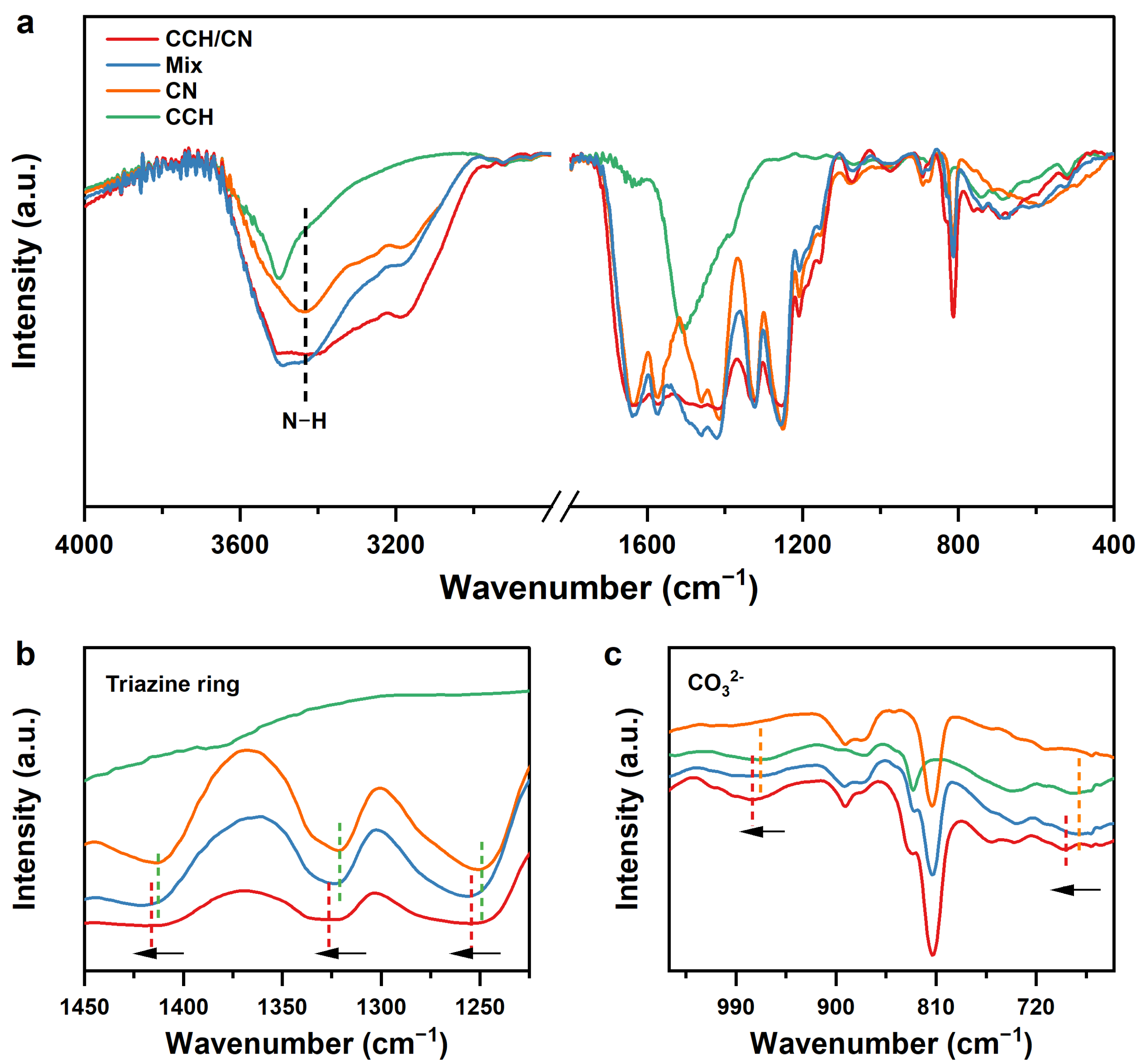
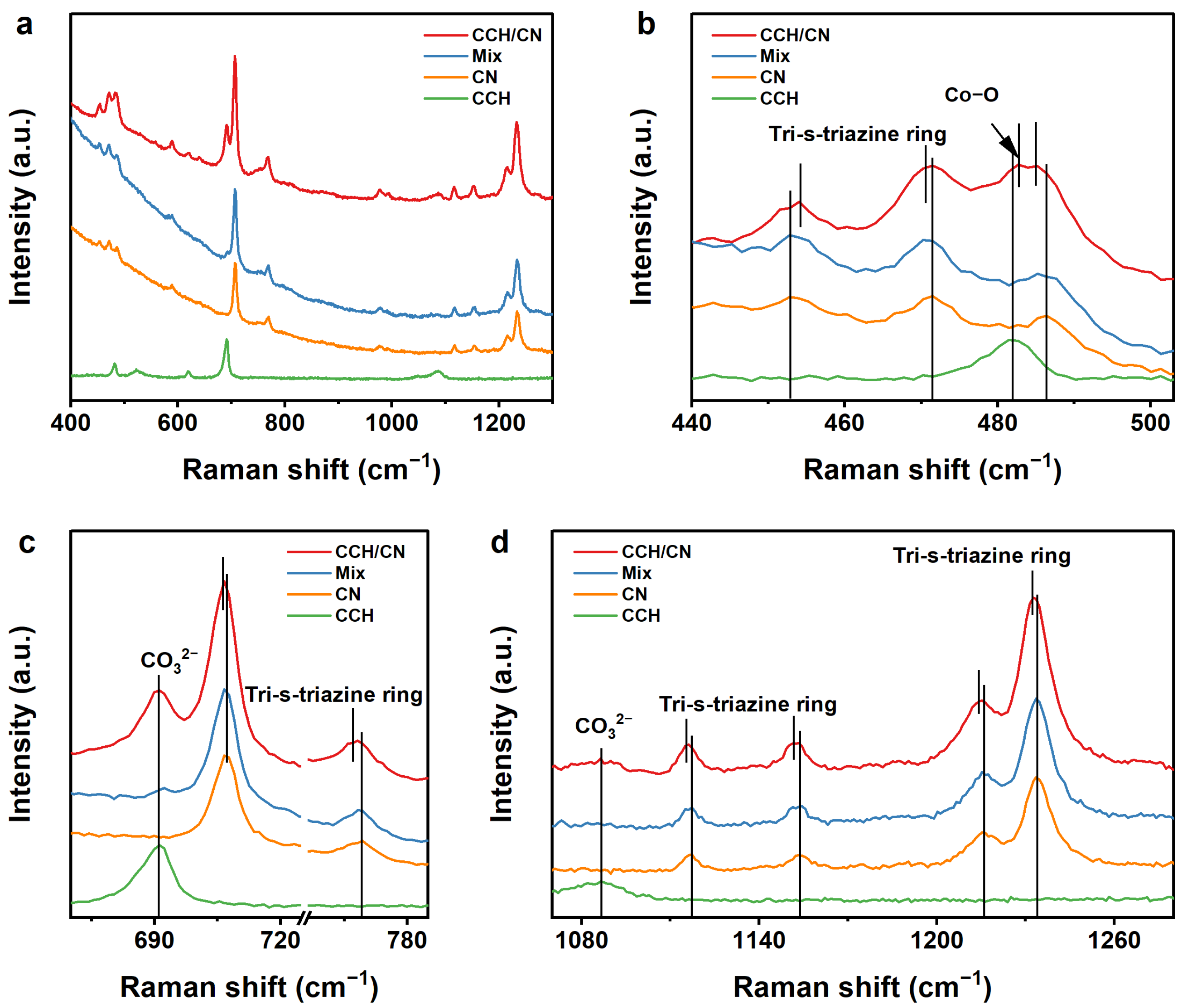
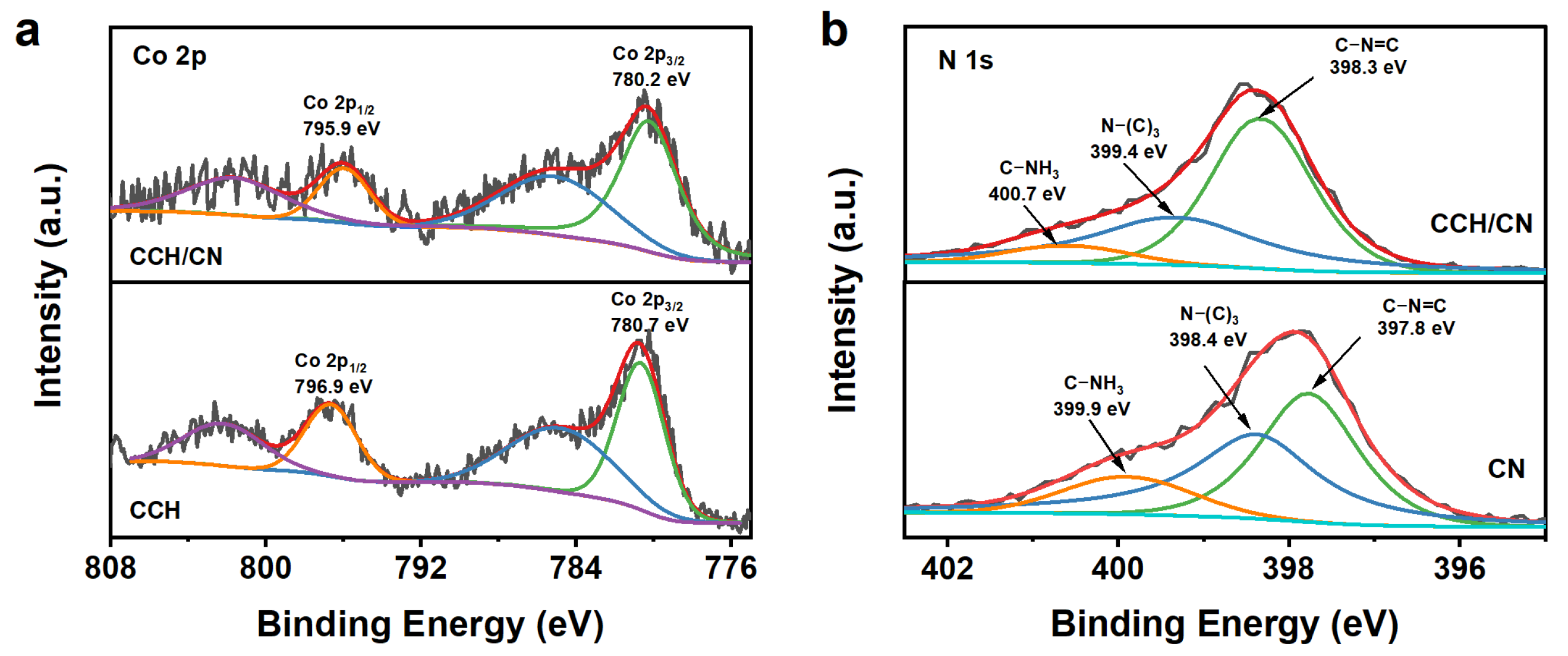
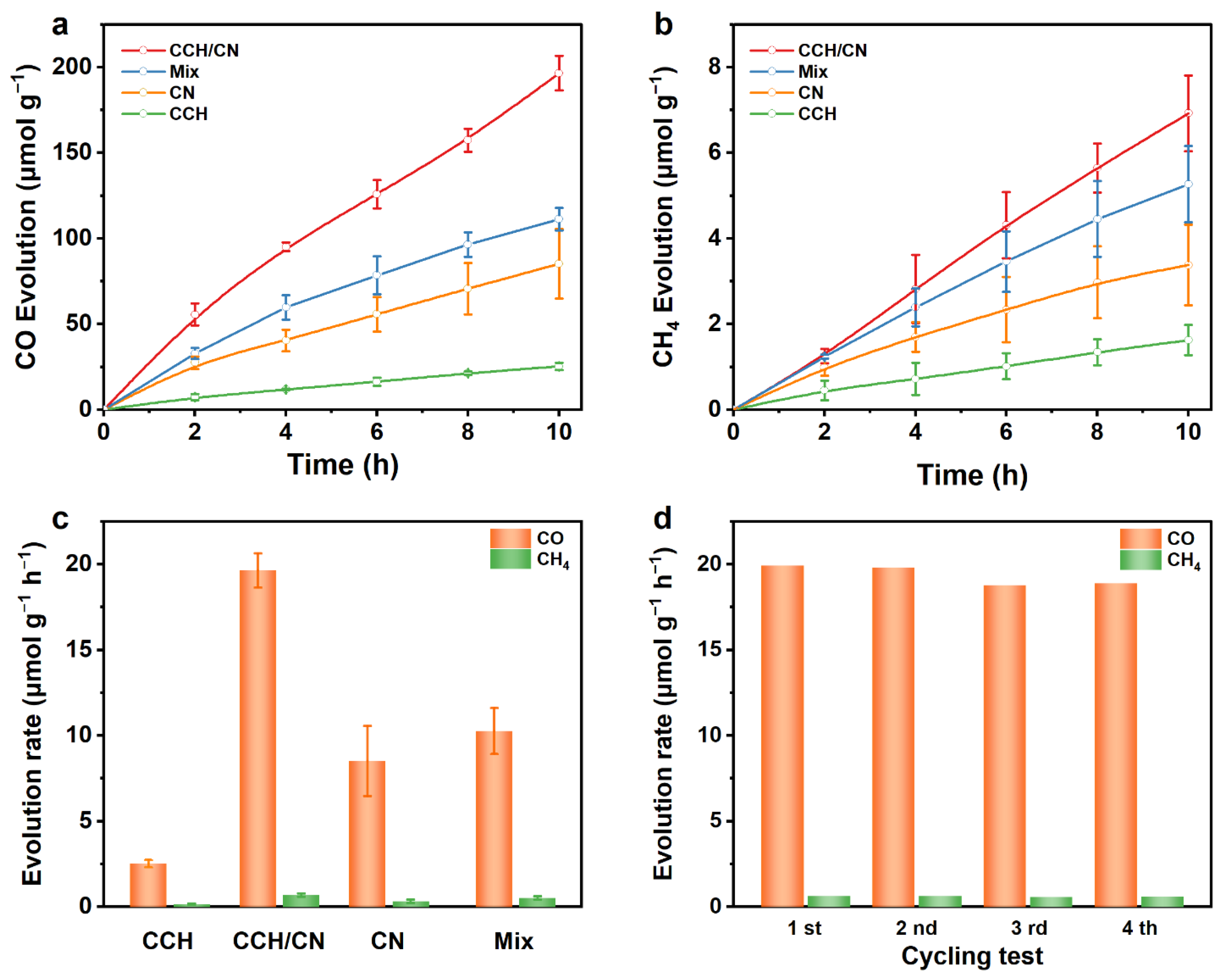
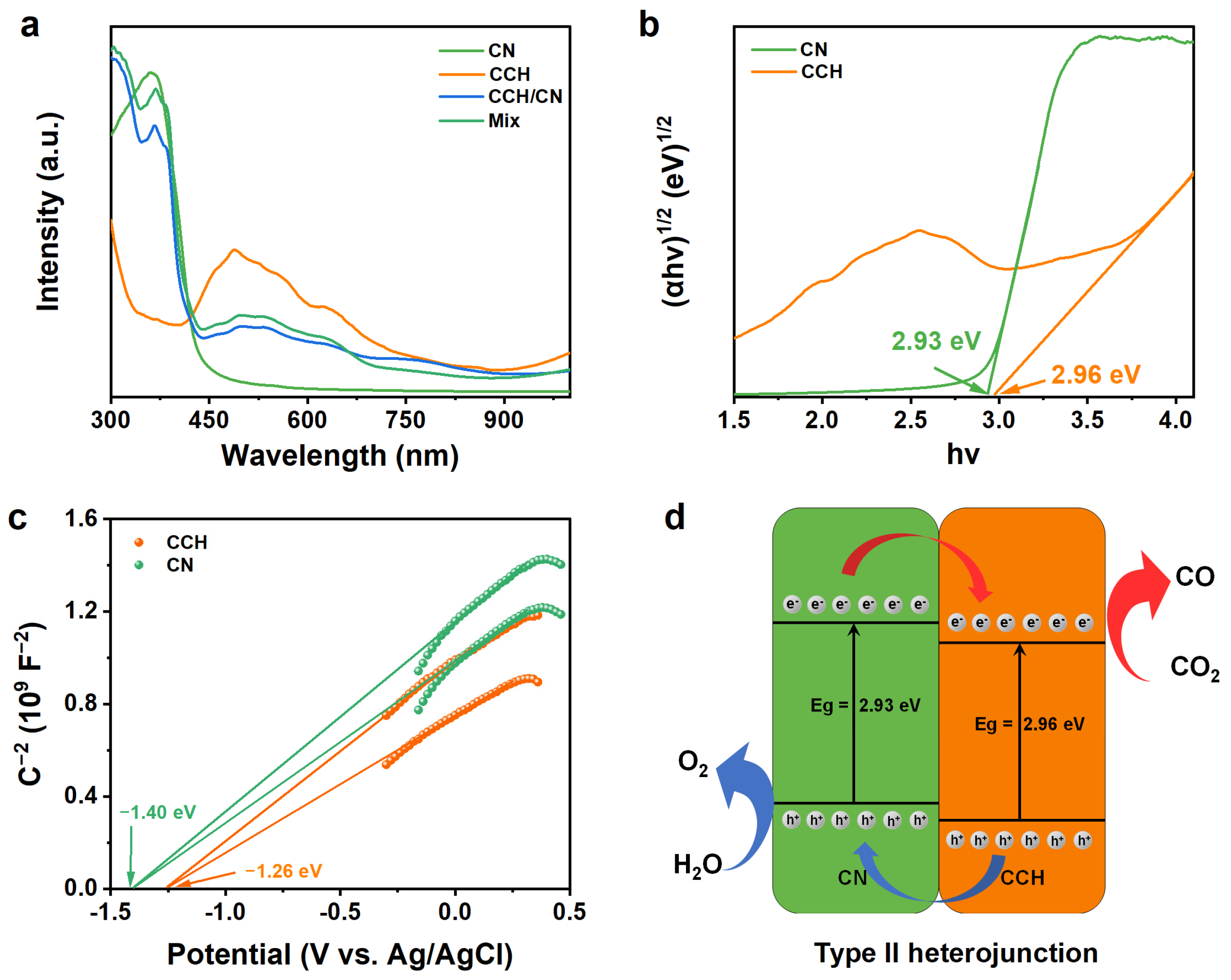

Disclaimer/Publisher’s Note: The statements, opinions and data contained in all publications are solely those of the individual author(s) and contributor(s) and not of MDPI and/or the editor(s). MDPI and/or the editor(s) disclaim responsibility for any injury to people or property resulting from any ideas, methods, instructions or products referred to in the content. |
© 2025 by the authors. Licensee MDPI, Basel, Switzerland. This article is an open access article distributed under the terms and conditions of the Creative Commons Attribution (CC BY) license (https://creativecommons.org/licenses/by/4.0/).
Share and Cite
Mo, X.; Zhong, H.; Hu, C.; Jin, H.; Liu, X.; Liu, H.; Zhang, G. Enhanced Photocatalytic CO2 Reduction via CCH/g-C3N4 Heterojunction: Optimizing Charge Carrier Dynamics and Visible-Light Utilization. Catalysts 2025, 15, 184. https://doi.org/10.3390/catal15020184
Mo X, Zhong H, Hu C, Jin H, Liu X, Liu H, Zhang G. Enhanced Photocatalytic CO2 Reduction via CCH/g-C3N4 Heterojunction: Optimizing Charge Carrier Dynamics and Visible-Light Utilization. Catalysts. 2025; 15(2):184. https://doi.org/10.3390/catal15020184
Chicago/Turabian StyleMo, Xinpeng, Hong Zhong, Chenhuan Hu, Haoxiong Jin, Xianfeng Liu, Huanhuan Liu, and Genqiang Zhang. 2025. "Enhanced Photocatalytic CO2 Reduction via CCH/g-C3N4 Heterojunction: Optimizing Charge Carrier Dynamics and Visible-Light Utilization" Catalysts 15, no. 2: 184. https://doi.org/10.3390/catal15020184
APA StyleMo, X., Zhong, H., Hu, C., Jin, H., Liu, X., Liu, H., & Zhang, G. (2025). Enhanced Photocatalytic CO2 Reduction via CCH/g-C3N4 Heterojunction: Optimizing Charge Carrier Dynamics and Visible-Light Utilization. Catalysts, 15(2), 184. https://doi.org/10.3390/catal15020184






